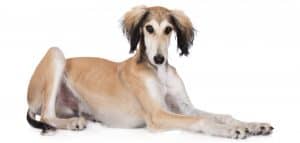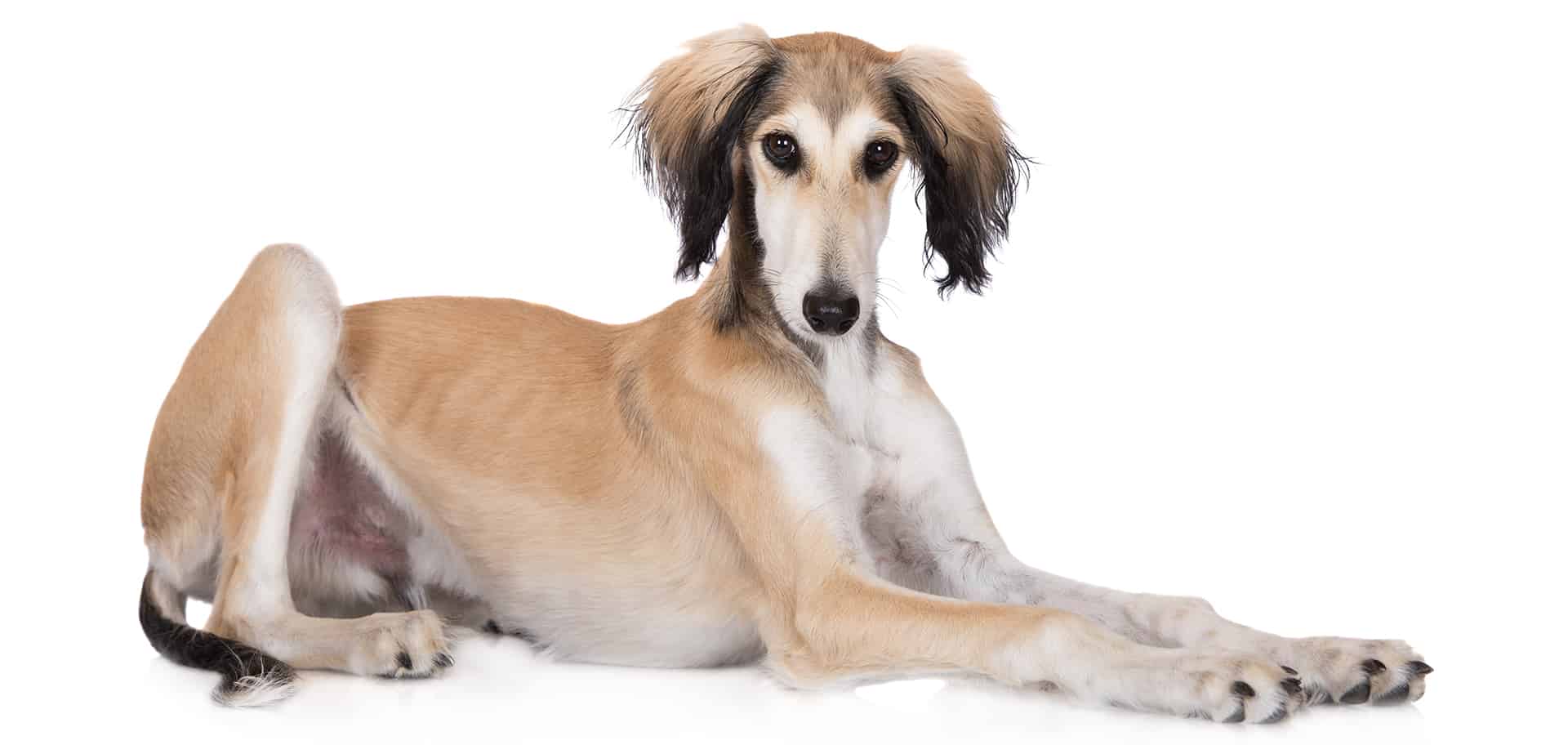The main part of the Saluki’s coat is easy to groom, requiring regular brushing with a bristle brush. The long hair on the ears, tail, and so on, needs regular attention with a slicker brush to remove mats. If the Saluki is inclined to grow fluff on the flanks, it can be removed with a stripping stone.
Coat: The coat of a Saluki is smooth, of silky texture, with feathering on the ears, tail, backs of the legs and between the toes. Puppies, and sometimes older dogs, may have a slight wooly feathering on the thigh and shoulder. The smooth variety has no feathering. All colors and combinations of colors are possible except for brindle.
Grooming Procedure
Equipment needed: How much grooming equipment you purchase will depend on how much grooming you are going to do on your Saluki
- Natural bristle brush
- Hound glove
- Slicker brush
- Metal comb
- Scissors
- Blaster
- Rubber mat
- Dog shampoo
- Spray hose attachment
- Ear cleaner
- Cotton wipes
- Towels
- Nail clipper
Breed tip: Use a snood while the dog is eating or chewing to save the long hair on the ears.
- Brush the long hair (particularly behind the ears) with a slicker brush and remove all mats.
- Brush the whole coat with a bristle brush to remove dead hairs.
- Bathe the Saluki in a good-quality shampoo and conditioner when necessary. The choice of shampoo is important, particularly on black-colored dogs, if the dog is inclined to shed dandruff.
- Dry the dog in warm air or with a gentle blower.
- Check the dog’s nails, ears and teeth.
Brushi ng the Coat
ng the Coat
A natural bristle brush or a hound glove can be used for regular routine brushing. Daily brushing is effective for removing dead hair and stimulating the dog’s natural oils to add shine and a healthy look to the coat. Although the smooth Saluki’s coat is short and close, it does require a five-minute once-over to keep it looking its shiny best.
The feathered Saluki requires more extensive grooming, although the silkiness of the hair reduces the likelihood of matting. Regular grooming sessions are also a good way to spend time with your dog. Many dogs grow to like the feel of being brushed and will enjoy the daily routine.
Bathing Your Saluki
Dogs do not need to be bathed as often as humans, but regular bathing is essential for healthy skin and a healthy, shiny coat. Again, like most anything, if you accustom your pup to being bathed as a puppy, it will be second nature by the time he grows up. You want your dog to be at ease in the bath or else it could end up a wet, soapy, messy ordeal for both of you!
Brush your Saluki thoroughly before wetting his coat. This will get rid of most mats and tangles, which are harder to remove when the coat is wet. Make certain that your dog has a good non-slip surface to stand on.
Begin by wetting the dog’s coat. A shower or hose attachment is necessary for thoroughly wetting and rinsing the coat. Check the water temperature to make sure that it is neither too hot nor too cold.
Next, apply shampoo to the dog’s coat and work it into a good lather. You should purchase a shampoo that is made for dogs. Do not use a product made for human hair. Wash the head last; you do not want shampoo to drip into the dog’s eyes while you are washing the rest of his body.
Work the shampoo all the way down to the skin. You can use this opportunity to check the skin for any bumps, bites or other abnormalities. Do not neglect any area of the body—get all of the hard-to-reach places.
Once the dog has been thoroughly shampooed, he requires an equally thorough rinsing. Shampoo left in the coat can be irritating to the skin. Protect his eyes from the shampoo by shielding them with your hand and directing the flow of water in the opposite direction.
You should also avoid getting water in the ear canal. Be prepared for your dog to shake out his coat—you might want to stand back, but make sure you have a hold on the dog to keep him from running through the house.
Ear Cleaning
The ears should be kept clean with a cotton wipe and ear powder made especially for dogs. Be on the lookout for any signs of infection or ear mite infestation. If your Saluki has been shaking his head or scratching at his ears frequently, this usually indicates a problem.
If his ears have an unusual odor, this is a sure sign of mite infestation or infection, and a signal to have his ears checked by the veterinary surgeon.
Nail Clipping
Your Saluki should be accustomed to having his nails trimmed at an early age, since it will be part of your maintenance routine throughout his life. Not only does it look nicer, but long nails can scratch someone unintentionally.
Also, a long nail has a better chance of ripping and bleeding, or causing the feet to spread. A good rule of thumb is that if you can hear your dog’s nails clicking on the floor when he walks, his nails are too long.
Pedicure tip: A dog that spends a lot of time outside on a hard surface, such as cement or pavement, will have his nails naturally worn down and may not need to have them trimmed as often, except maybe in the colder months when he is not outside as much.
Regardless, it is best to get your Saluki accustomed to the nail trimming procedure at an early age so that he is used to it. Some dogs are especially sensitive about having their feet touched, but if a dog has experienced it since puppyhood, it should not bother him.
Before you start cutting, make sure you can identify the ‘quick’ in each nail. The quick is a blood vessel that runs through the center of each nail and grows rather close to the end.
It will bleed if accidentally cut, which will be quite painful for the dog as it contains nerve endings. Keep some type of clotting agent on hand, such as a styptic pencil or styptic powder (the type used for shaving). This will stop the bleeding quickly when applied to the end of the cut nail.
Do not panic if you cut the quick, just stop the bleeding and talk soothingly to your dog. Once he has calmed down, move on to the next nail. It is better to clip a little a time, particularly with black nailed dogs.
Hold your pup steady as you begin trimming his nails; you do not want him to make any sudden movements or run away. Talk to him soothingly and stroke him as you clip. Holding his foot in your hand, simply take off the end of each nail in one quick clip.
You can purchase nail clippers that are specially made for dogs; you can probably find them wherever you buy pet or grooming supplies.
Using a grinder is a good alternative for many owners. These are available from specialty catalogues, or you can use the kind found in the hardware store. The tool is a hand-held power tool, often cordless. It has a small drum that can be fitted with coarse sandpaper.
Since it is light and easy to hold, you can use it often, daily if necessary, to keep your dog’s nails smooth and short.

